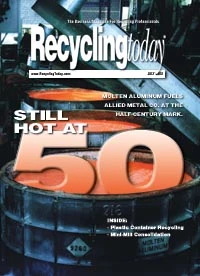The previous decade has been a wild one for nonferrous metals recyclers, with changes coming from all directions. A sustained, healthy economy in the U.S. was the hallmark of the 1990s, although many in the metals industry did not always benefit from the investment money being poured into high-tech firms.
But the healthy economy meant a lot of new buildings and homes were constructed, vehicle production figures hit record numbers, and electronic gadgets in the computer and telecommunications sectors were being manufactured in record numbers. All of these industries used nonferrous metals products, meaning there was seldom any lack of demand for nonferrous scrap throughout the boom economy years.
That is not to say that recyclers always benefited from high prices and wide margins when dealing in nonferrous scrap. A number of factors have kept Comex copper and LME aluminum prices fluctuating during the past 10 years.
Shipping patterns have changed also, for red metals in particular. Concerns over emissions and worker safety at scrap-melting copper refineries saw that industry virtually disappear from the U.S. map. While brass mills and some other copper-consuming plants continue to operate, the unmistakable flow of huge amounts of copper to China and other overseas destinations has greatly changed the nature of scrap copper dealing.
Two of the features in this year’s Nonferrous Scrap Supplement take a look at what might be in store during the next 10 years for two of the most prominent nonferrous metals: aluminum and copper. Alcan Inc. Executive Vice President Brian Sturgill offers comments on the opportunities and challenges faced within his industry, while researcher Emil W. Milker takes a look at how emerging technology trends may affect end markets for copper.
On the lighter side, we take a look at stainless steel and whether this hybrid material should be considered a ferrous or a nonferrous metal. It contains plenty of iron, so clearly it should be considered ferrous, right? But in the recycling industry, its price is most closely pegged to the nickel alloyed within, and it is seldom lumped together with carbon steel in scrap yards. Find out what several industry observers think in our feature, "The Great Debate?" starting on page S14.
Get curated news on YOUR industry.
Enter your email to receive our newsletters.

Explore the July 2002 Issue
Check out more from this issue and find your next story to read.
Latest from Recycling Today
- Recycled steel price crosses $500 per ton threshold
- Smithers report looks at PCR plastic’s near-term prospects
- Plastics association quantifies US-EU trade dispute impacts
- Nucor expects slimmer profits in early 2025
- CP Group announces new senior vice president
- APR publishes Design Guide in French
- AmSty recorded first sales of PolyRenew Styrene in 2024
- PRE says EU’s plastic recycling industry at a breaking point





